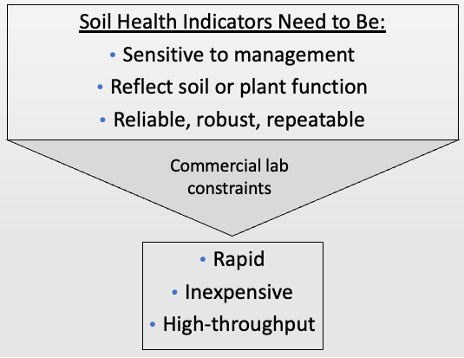Author: Steve Culman, Distinguished Endowed Chair in Soil Health for Potato Cropping Systems, Washington State University
The essentials
My 8-year old daughter recently told me, “Daddy, I had THE BEST cookie at school today.” When I asked why it was the best, she immediately began to explain all the reasons this cookie was so wonderful, “Twice as big as a normal cookie,” “Shaped like a snowman,” “Colorful frosting with all kinds of colors,” “Soft and chewy.” The list went on.
Just as my daughter had extensive criteria for what makes a cookie good, we can also think about criteria for what makes a soil health indicator good. By indicator, I mean any available soil test or measurement that reflects a soil or plant function. A Bray-P soil test value indicates phosphorus availability to the crop. Similarly, indicators can reflect other soil functions, such as moisture holding capacity, soil structure, or biological activity. And just like cookies, soil health indicators all have attributes that can make them ‘the best’ or relegate them to the last chosen from the cookie jar.
Over the last century, soil scientists have developed many, many methods to measure all kinds of soil properties. There are volumes of reference books that outline these methods. But we can’t measure everything, so how do we choose just a few? What are the essential things that make for a good soil health indicator?
Good soil health indicators have to be many things. And they have to stand up to the very real constraints of commercial soil testing labs, which often run hundreds or thousands of soil samples each day (Figure 1).

So, what soil health indicators satisfy these criteria? The short answer is not many. The longer answer is to look to what some commercial soil testing laboratories are now offering. It’s not a long list and varies some from lab to lab. Likely some methods don’t exist yet and still need to be invented – just like my daughter’s ground-breaking marshmallow-peanut butter-skittle-chocolate chip cookie surprise.
And we haven’t even talked about which combination of indicators should collectively make up a soil health test. That’s for another time. Short answer is it’s complicated.
Building on soil chemistry
The agricultural industry enjoys an incredible soil testing infrastructure for routine nutrient analysis that helps us manage nutrients more effectively. This includes everything from a private consultant industry that will help sample your soils to professional soil testing laboratories that will analyze your soils quickly and consistently. Right down to the nutrient recommendations that have been developed over the decades for specific crops. These are all important pieces that inform us of what is required for optimal crop fertility. It’s easy to take this all for granted.
Soil health testing seeks to build on this infrastructure by providing additional information to farmers. Rather than focusing solely on soil chemistry, soil health testing seeks to provide farmers insight into the biological and physical components of soil and tie it all together in a common framework. This is a tall order, and there’s a lot of work that remains.
And although I don’t share the same affinity that my daughter has for oversized and over-sugared cookies, I have to say I’m pretty opinionated about soil health indicators. There are some good ones currently out there. Stay tuned because soil scientists are working hard to understand which indicators are ‘the best’ and what combinations give us the most information about what’s happening in the soil.

Interesting in sampling for soil health? Check out some WSU resources at this link.